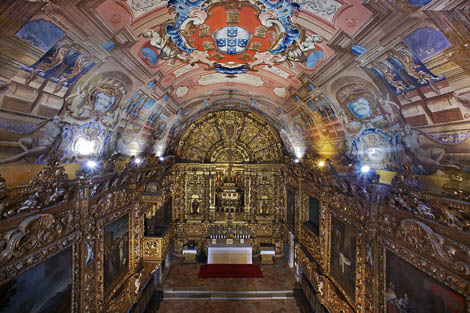 150 thousand euros. This is the minimum amount needed to recover the vault and roof of the Church of Santo António, in Lagos, which is closed for precaution since October of last year.
150 thousand euros. This is the minimum amount needed to recover the vault and roof of the Church of Santo António, in Lagos, which is closed for precaution since October of last year.
The amount is the result of a first estimate made after the exhaustive process of diagnosing the problems of that church classified as a national monument, which is the second most visited place in the Algarve, right after the Fortress of Sagres.
The diagnosis, already discussed at a meeting between the Chamber and the Regional Directorate of Culture on 26 March, concluded that, for safety reasons, there must be work on the building before its reopening to the public.
The diagnosis involved technicians from the municipality of Lagos - namely the architect Frederico Paula, from the municipal company Futurlagos -, technicians from the Regional Directorate of Culture, specialized companies such as OZ Diagnostics and STAP, and also from the University of Algarve, as well as technologies and methods probably never before used in the region to assess the condition of a monument, such as vault endoscopies. The entire painted vault, the carvings, the roof and other structures of the building located in the historic center of Lagos, half-walls with the Municipal Museum, were also recorded in photography and video.
And the result of the diagnosis, presented last Thursday at a public session in Lagos, is that, in fact, although the situation of the secular church is not as serious as it was feared, it was a wise move to close the monument to visitors of tourists, and it is now urgent to carry out works. These works, for now, and before there is an execution project and more detailed budgets, are valued at 150 thousand euros. A sum that the Câmara de Lagos, owner of the classified property does not have, as I told the Sul Informação its vice president Hugo Pereira.
Problems diagnosed
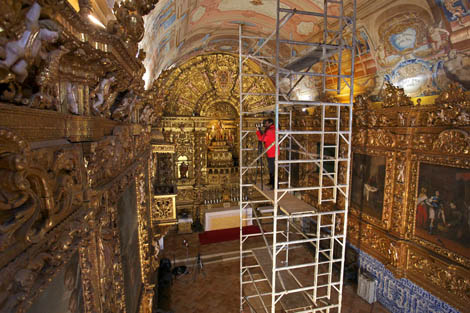 From the diagnosis, it was concluded, according to the architect Frederico Paula, that there is in fact "a detachment between the plaster and the vault, which could be problematic", although the vault itself is in good condition, much better than expected . However, because certain areas of the painted plaster can, at any time, fall and cause damage or victims, the church must be kept closed until the necessary intervention is carried out.
From the diagnosis, it was concluded, according to the architect Frederico Paula, that there is in fact "a detachment between the plaster and the vault, which could be problematic", although the vault itself is in good condition, much better than expected . However, because certain areas of the painted plaster can, at any time, fall and cause damage or victims, the church must be kept closed until the necessary intervention is carried out.
In worse condition is the gable roof covered with tile. Here, urgent works will also have to be carried out, since «there are problems in the wooden structure of the roof», which is «very deformed and with fractured elements». It is also at the level of the roof that rainwater infiltrations are registered, which are causing problems in one of the corners of the painted vault.
The diagnosis made it possible to verify, once and for all, that the vault of the Church of Santo António, contrary to what some official texts said, is not made of wood, but of mortar stone masonry, about 40 centimeters thick. . The vault is then covered by the roof.
The work done by the technicians also detected other anomalies in the national monument: some elements of the very rich gilded wood carving that covers its interior are at risk of falling, the pulpit cover, also in gilded wood carving, can also fall (and has been propped up in the meantime), the metal elements for fixing the bells show signs of corrosion and, finally, the lighting system is obsolete and even causes «disastrous effects» on the structure and decorative elements of the church.
However, despite these problems, and in short, “the vault is currently stable and with no signs of imminent fall risk”, but “the plaster is not stable” and needs urgent intervention.
Frederico Paula admits that the risks of the painted plaster falling are not great, "they will be between 5% and 10%". But even so, “this is not a toy, especially when the church used to receive group visits, it can happen and have serious consequences. And, because we are in a seismic zone, a small shake can cause a fall».
Therefore, concluded the architect responsible for the historic center of Lagos in his presentation, which had in the audience two councilors, other mayors, several municipal technicians, employees of the Municipal Museum and a journalist, "the church should be the target of rehabilitation and reinforcement intervention with as soon as possible'.
Innovative solution
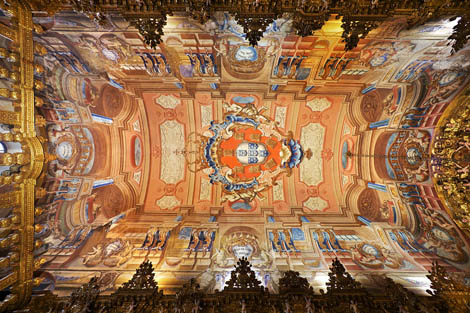 The corrective measures were already discussed at a recent meeting between the City of Lagos and the Regional Directorate of Culture, which oversees the monument. There are several solutions, some of them more conservative ou normal, although with debatable aesthetic results, but the one that should be implemented was proposed by Carlos Martins, engineer and professor at the University of Algarve.
The corrective measures were already discussed at a recent meeting between the City of Lagos and the Regional Directorate of Culture, which oversees the monument. There are several solutions, some of them more conservative ou normal, although with debatable aesthetic results, but the one that should be implemented was proposed by Carlos Martins, engineer and professor at the University of Algarve.
«It is a solution that will solve all the problems detected at the same time», explained Frederico Paula, who classified it as a «unique technique». It involves the construction of a concrete sheet over the vault (between this and the roof), reinforced with carbon fiber, with a series of stainless steel connectors, in order to hold the vault, then building a kind of ribs, almost like curved beams, spaced along the vault. Thus, the roof ridge would no longer discharge onto the vault and would immediately eliminate many of the problems that caused deformation.
As for the roof, the option should be for its complete replacement, with new tile and providing it with thermal and water-repellent insulation (against water).
Complementary work should also be carried out (repair and cleaning of the gilded woodcarving, repair of the bells, replacement of the lighting system), as well as a new intervention: the repair of the south bell tower, which would be made visitable, thus complementing the visit to the church of Santo António for those who feel more adventurous.
The project of the necessary interventions should be completed "by the end of April". And only then can rigorous calculations be made about how much all these works will cost. The estimated cost, totaling 150 thousand euros, foresees 50 thousand for gluing the plaster to the vault, 50 thousand for the vault and as much for the roof. In this initial budget, the suggested complementary works are not yet included.
Where does the money come from?
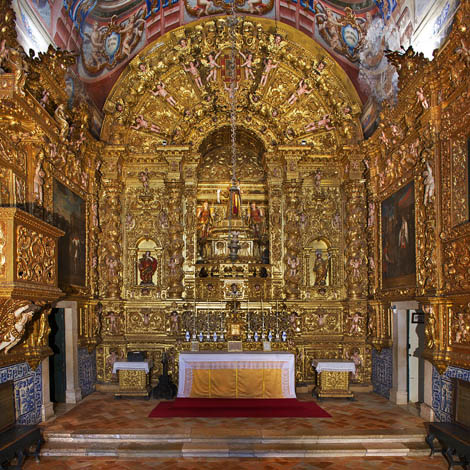 Who will pay for the works? The municipal company Futurlagos had applied for the Algarve 21 Operational Program, in the meantime, for less extensive works on the roof of the church. Now verifying that a deeper intervention is needed, «the possibility of these funds being reprogrammed and channeled is being studied with the CCDRA» for what is now necessary to do, he revealed to the Sul Informação the vice president of the Chamber Hugo Pereira. "The CCDRA is sensitive to this," he assured.
Who will pay for the works? The municipal company Futurlagos had applied for the Algarve 21 Operational Program, in the meantime, for less extensive works on the roof of the church. Now verifying that a deeper intervention is needed, «the possibility of these funds being reprogrammed and channeled is being studied with the CCDRA» for what is now necessary to do, he revealed to the Sul Informação the vice president of the Chamber Hugo Pereira. "The CCDRA is sensitive to this," he assured.
And how long will the work take once it starts? Architect Frederico Paula says that it should take "three months, another month for the intervention in lighting and carvings."
The decision of the Municipality of Lagos is to reopen the Church of Santo António to the public, as soon as the security conditions are back in place, after the works. Even because the rich baroque gilded interior attracts thousands and thousands of tourists, who visit the church and the nearby museum, which live a lot of this movement. It is an important source of revenue for the municipality, which has suffered a notable drop since, in October last year, the decision was taken to close the church to the public.
«It is a complicated intervention, but absolutely necessary», reinforced Frederico Paula. "With the project in hand, it is important to launch an internal discussion about how the work will be done and what the strategy for reopening the property is," added the architect. It was even suggested that, even during the course of the work, there could be more controlled visits, namely by engineering students, technicians and other people interested in preserving the heritage.
“The works really have to start, since the decision is to reopen the church”, concluded Frederico Paula.
Photos: Provided by the Municipality of Lagos, rights reserved.












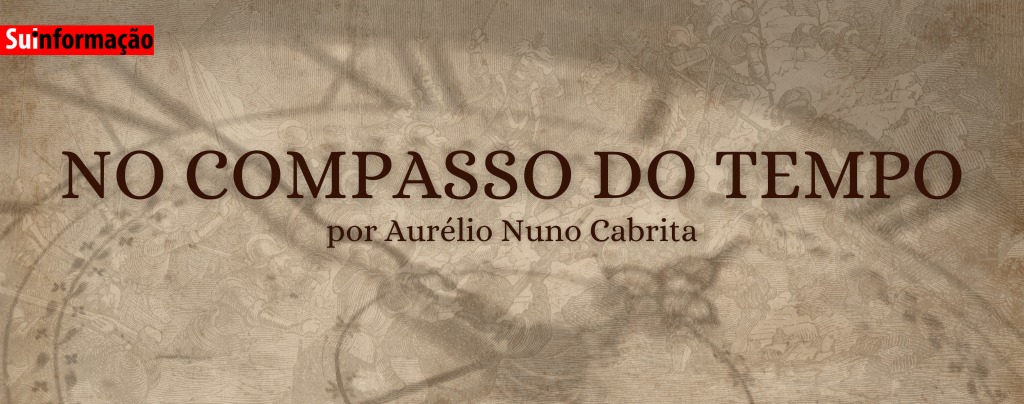





Comments